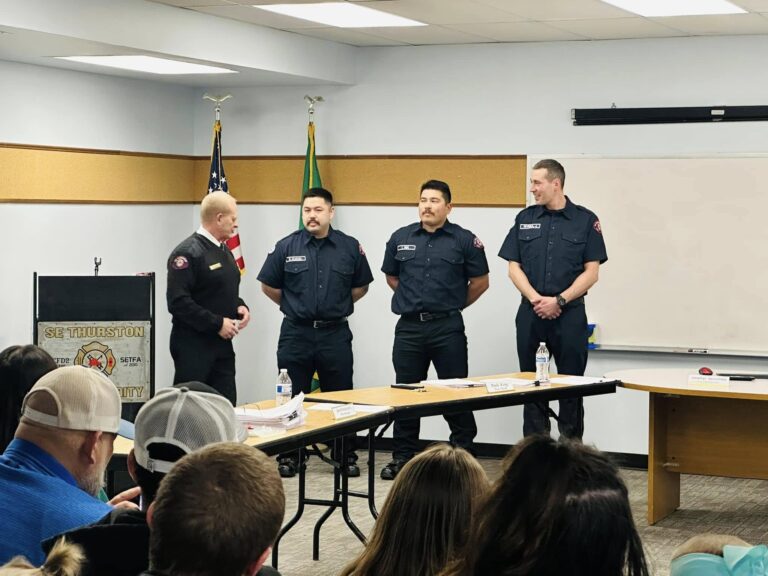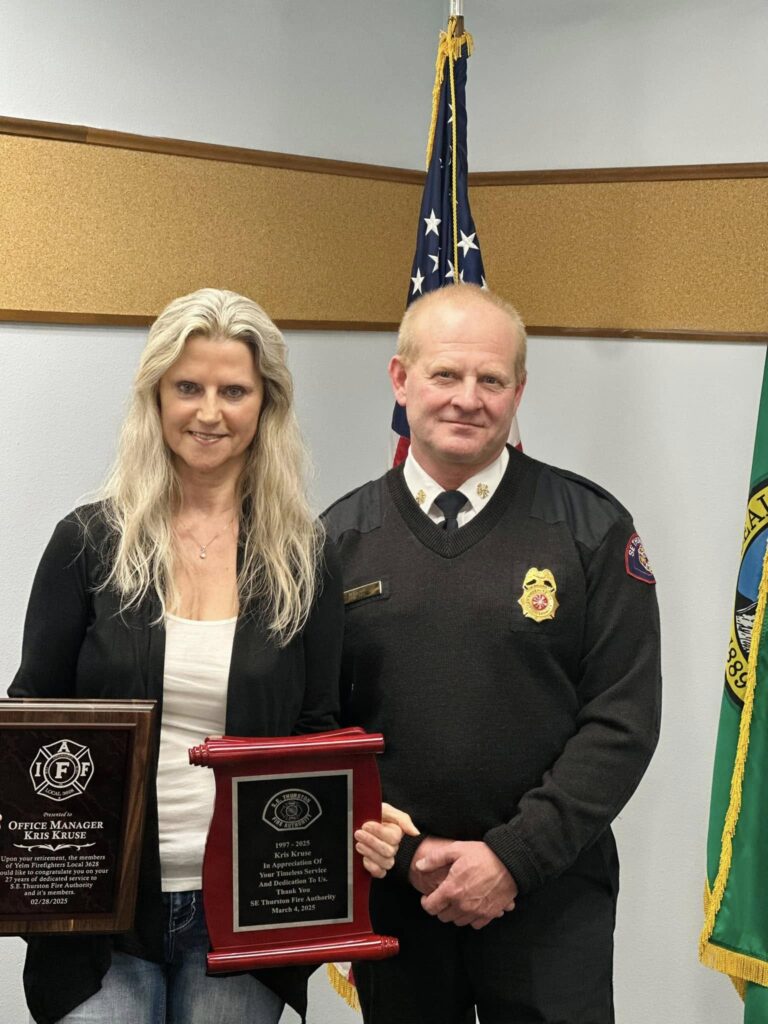Fire authority commended for transparency and accountability

Serving the cities of Yelm, Rainier, and surrounding unincorporated areas. (360) 458-2799
(360) 458-2799

Fire authority commended for transparency and accountability
As warmer weather brings us outdoors, many families enjoy backyard activities like grilling, fire pits, and campfires. While these moments create lasting memories, they also bring increased fire risks, especially during dry months. At SETFA, your safety is our priority. Here’s what you need to know to enjoy your backyard safely and responsibly.
1. Check Local Regulations
Always verify if there’s a burn ban or restriction in place. Conditions change quickly during fire season; even small backyard fires can pose serious risks during dry, windy days. Visit [your local fire authority’s website] or call your fire district to stay updated.
2. Choose the Right Location
Keep fire pits, grills, and burn barrels:
3. Use Proper Equipment
4. Stay Attentive
5. Fully Extinguish Fires
When you’re done:
6. Position Your Grill Wisely
If a fire gets out of control:
Backyard fires can be safe and enjoyable with a few simple precautions. Whether you’re roasting marshmallows, hosting a cookout, or burning yard debris, remember: One spark is all it takes.
Stay safe, stay informed, and help protect your family and neighbors. For more fire safety tips or local regulations, visit SEthurstonfire.org or follow us on social media.
As the rain-soaked days of winter give way to the fresh blooms and warmer temperatures of spring, Yelm residents are stepping back outside — tidying yards, firing up grills, and planning outdoor adventures. But with the change in season comes a renewed need to focus on fire safety around homes and neighborhoods.
At the heart of Yelm’s strong community spirit is the shared responsibility to protect the people, properties, and wild spaces that make our area special. Here are a few important reminders to help you and your neighbors stay safe this spring.
Spring is the perfect time to clear away debris left behind by winter storms. Dry leaves, dead branches, and tall grass are more than just unsightly — they’re potential fuel for fires.
Yelm Fire Safety Tip:
Before you light that pile of brush or debris, check whether a burn ban is in effect. Even in early spring, dry and windy conditions can quickly cause fires to spread.
Yelm Fire Safety Tip:
As the days get longer, backyard barbecues and camping trips start to fill the calendar. While these are great ways to enjoy the season, they also require smart fire practices.
Yelm Fire Safety Tip:
Spring can sometimes be deceptively dry in Yelm, especially during periods of sunny weather preceding the official arrival of summer. Stay aware of fire risk levels in Thurston County, especially if you live near wildlands.
Yelm Fire Safety Tip:
Fire safety is truly a community effort. Whether it’s lending a hand with a neighbor’s yard clean-up, reporting suspicious smoke, or volunteering for a local safety program, small actions make a big difference in protecting Yelm.
For more updates on fire safety, regulations, and preparedness, visit:
👉Visit our facebook page
Let’s work together to keep Yelm safe, green, and fire-free this spring!
Spring is the perfect time to clean up and declutter your home and prepare for warmer weather. Keeping fire safety in mind during your spring cleaning efforts is essential.
1. Safely Store Flammable Liquids
Avoid piling grass clippings, dried leaves, or other flammable materials near your home or garage as you work in your yard. Store gasoline and other flammable liquids in proper and original containers, away from direct sunlight and heat sources.
Incorporating these fire safety measures into your spring cleaning routine can help protect your home and loved ones from potential fire hazards.
2. Maintain Electrical Safety
Inspect all electrical cords for signs of wear, fraying, or damage. Replace any faulty cords immediately, and avoid overloading outlets with multiple plugs. If using extension cords, make sure they are rated for their intended use to prevent potential fire hazards.
3. Check Smoke Alarms
Test smoke alarms and carbon monoxide detectors throughout the home. Replace batteries if needed and clean dust that may interfere with their function.
4. Dispose of Flammable Clutter
Spring cleaning often involves clearing out old newspapers, magazines, cardboard boxes, and other clutter that can fuel a fire. Dispose of these materials correctly and store essential documents in fireproof containers to minimize risks.
5. Be Careful with Cleaning Supplies
Many household cleaning products contain flammable chemicals. Store cleaning products away from heat sources and ensure proper ventilation while using them. Never mix cleaning chemicals, as this can create hazardous fumes that may lead to injury and dangerous situations.
6. Clean Dryer Vents and Filters
The build-up of lint in dryer vents and filters is a leading cause of home fires. Regularly clean out lint traps after each use and schedule a deep cleaning of your dryer vent system to prevent overheating and fire risks.
This past weekend, members of SE Thurston Fire Authority put their strength and endurance to the test by participating in the Columbia Tower Stair Climb, an annual event dedicated to raising funds and awareness for the Leukemia & Lymphoma Society (LLS). Our firefighters tackled an incredible challenge—ascending 69 floors and 1,356 grueling steps—all while wearing full turnout gear and SCBA (self-contained breathing apparatus).
The climb is more than just a test of physical endurance; it’s a powerful tribute to those battling blood cancers. Our firefighters honored patients, survivors, and those we’ve lost with every step, demonstrating unwavering commitment to the cause. This event brings together first responders from across the nation, all united by a shared mission: to support life-saving research and provide hope for those affected by leukemia, lymphoma, and other blood disorders.
A huge shoutout to Jeff Brown and Sam Banner for taking on this demanding challenge! Their dedication, perseverance, and team spirit exemplify the heart of SE Thurston Fire Authority. Thank you to everyone who supported our team and contributed to this important cause. Together, we’re making a difference—one step at a time!


Falls are the leading cause of fatal and nonfatal injuries among adults 65 and older. Fire departments can play an important role in reducing falls among this age group by promoting fall prevention in community safety outreach activities.
Did you know:
Each year, 1 in 4 older adults aged 65 and older experiences a fall, and people who fall once are 2 times more likely to fall again.
House fires can be devastating, causing loss of property, injuries, and even fatalities. Understanding the most common causes of house fires and how to prevent them can help keep your home and family safe. Here are some of the leading causes and prevention tips.
Unattended cooking is one of the top causes of house fires. Grease fires, overheating appliances, and flammable materials near heat sources contribute to these fires. Prevention:
Faulty wiring, overloaded outlets, and damaged appliances can cause electrical fires. Prevention:
Space heaters, fireplaces, and furnaces can ignite fires if not used properly. Prevention:
Cigarettes, cigars, and other smoking materials can ignite fires if improperly disposed of. Prevention:
Candles left unattended or placed near flammable objects can cause fires. Prevention:
Lint accumulation in dryer vents can ignite and cause fires. Prevention:
Gasoline, paint thinners, and other flammable liquids can ignite from heat or sparks. Prevention:
Kids playing with matches, lighters, or candles can unintentionally start fires. Prevention:
Preventing house fires starts with awareness and proactive measures. Regular inspections, safe practices, and proper fire safety equipment can significantly reduce the risk of fires in your home. Stay prepared and prioritize fire safety to protect your loved ones and property.
If you have questions about fire safety or need assistance, contact your local fire department for guidance and resources.
As the colder days are upon us and we seek comfort and warmth, it is important to remember fire safety should be a top priority when using fireplaces and fire pits. While these items provide a cozy atmosphere, they also come with potential hazards if not used properly.
Whether you have a traditional wood-burning fireplace, a gas fireplace, or an electric model, safety is key.
Outdoor fire pits are great for entertaining or creating a cozy ambiance in your backyard, but they also come with safety considerations.
Space heaters are an efficient way to warm up a room, but they must be used with care to prevent overheating or fires.
Following these safety tips, you can enjoy the warmth and comfort of your fireplace, fire pit, or space heater without putting yourself or your loved ones at risk. As the temperature drops and we spend more time indoors and around outdoor fires, remember that fire safety is a shared responsibility that starts with awareness and careful practices.
Prevent burns and scalds in the kitchen:
General first aid for burns and scalds: